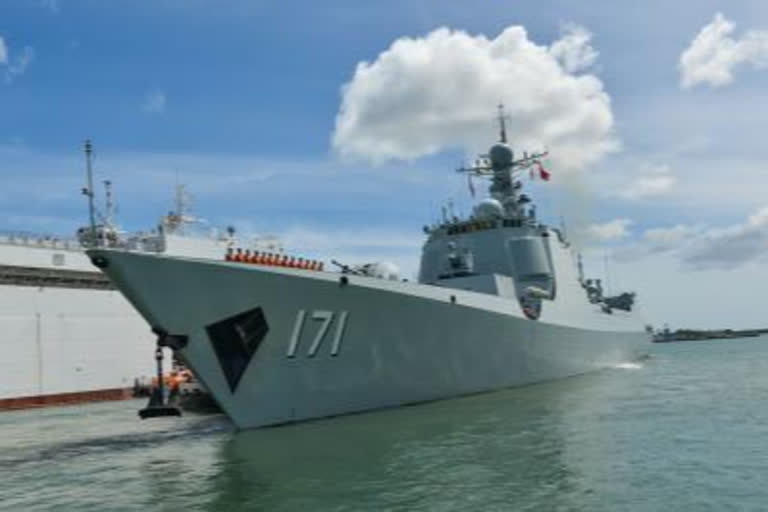New Delhi: Jon Huntsman, the US Ambassador to Russia, post landing on the USS Abraham Lincoln on April 23, 2019, had remarked, "Each of the carriers operating in the Mediterranean represents 100,000 tonnes of international diplomacy." Exactly two years later, on April 23, 2021, the Chinese Communist Party (CCP) Navy demonstrated its own capability of naval military diplomacy when, on the same day, it commissioned a Type-55 Renhai-class cruiser, a Type-75 Landing Helicopter Deck and a Type-094 SSBN with a cumulative tonnage of 70,000 tonnes.
The statement of intent is clear. Discarding its continental mindset, China, the second-largest economy in the world, aims to be a global maritime power of the magnitude of the British Empire in the late 17th/18th century and the United States in the 19th/20th century. The rate at which the CCP Navy has been inducting new warships has been the cynosure of many world navies. Between 2000 and 2020, the CCP Navy commissioned a staggering 195 major combatants such as destroyers, frigates, tankers, submarines, landing ships and corvettes. More astounding is the fact that 138 of these were inducted into service in the last 10 years at an average of 13.8 per year, with 26 platforms being commissioned in 2020 itself. Whether it be through reverse engineering or licensed production or cyber espionage or through outright copying, the feat is truly remarkable by any account.
Sometime between 2015 and 2020, the CCP Navy also crossed a critical threshold. It fielded more warships than the US Navy, making it the world's largest navy numerically. Today, at around 360 hulls, it exceeds its American rival by more than 60 warships and the gap continues to grow rapidly. Add to it the two other maritime forces -- the Coast Guard and Maritime Militia -- and the CCP Navy in total has over 700 ships even by conservative accounting.
Read: Amid competition with US, China building over 100 missile silos in western desert: Report
While there was been some scepticism with regard to the combat capabilities of CCP Navy assets, the new generation platforms, like the Type-55 Renhai class, are technologically similar to the latest being inducted by Western Navies and are likely to be the mainstay of the CCP Navy's Carrier Strike Force as well as distant operations task groups. Anyway, the numbers too do matter sometimes, especially if one is to contest in the dense combat environment in the littoral waters of the South and the East China Sea. So, borrowing the tagline of the popular Discovery Channel series – ‘How did they do it?
It all started in the 1980s and 90s when the CCP famously ‘opened up' all defence manufacturing sectors to civilian production. The booming global commercial shipbuilding industry was an added bonus and China, taking advantage of a state-provided economic stimulus and cheap labour market, soon surpassed South Korea as the world's largest shipbuilder in 2010. This resulted in the sudden mushrooming of smaller and medium-sized shipbuilding enterprises, all vying for the lucrative global market. At one time in 2013, China had more than 800 shipyards and a large number of dry docks. In comparison, matured players like South Korea had only about 20 shipyards. This unprecedented growth, pushed by the senior-most leadership of the CCP, has seen the shipbuilding industry in China grow by 13 times between 2002 and 2012.
Trouble began after the 2008 global financial crisis, which resulted in a sudden downturn in demand for shipping. As a result, most of the Chinese shipbuilding enterprises were operating at drastically lower capacities. This is when the CCP decided to step in to protect its shipbuilding industry and started giving government contracts for warship production to some of its preferred yards. This resulted in a sudden spurt in warship production, primarily due to China's socio-economic necessities rather than its operational requirements.
As mentioned earlier, the period between 2013 and 2020 witnessed a meteoric rise in warship production. Such a rise in force levels surely met CCP's geostrategic agenda too. The CCP Navy is likely to become a 4-carrier Navy by the end of this decade and could have 10 carriers by 2049. Presently, they appear to be focusing on integrating their aircraft carriers and the associated carrier battle groups (CBG) with their fighter squadrons. And it's not just the numbers, even the speed of construction has been astounding.
Read: Firmly in control, China’s Communist Party marks centenary
